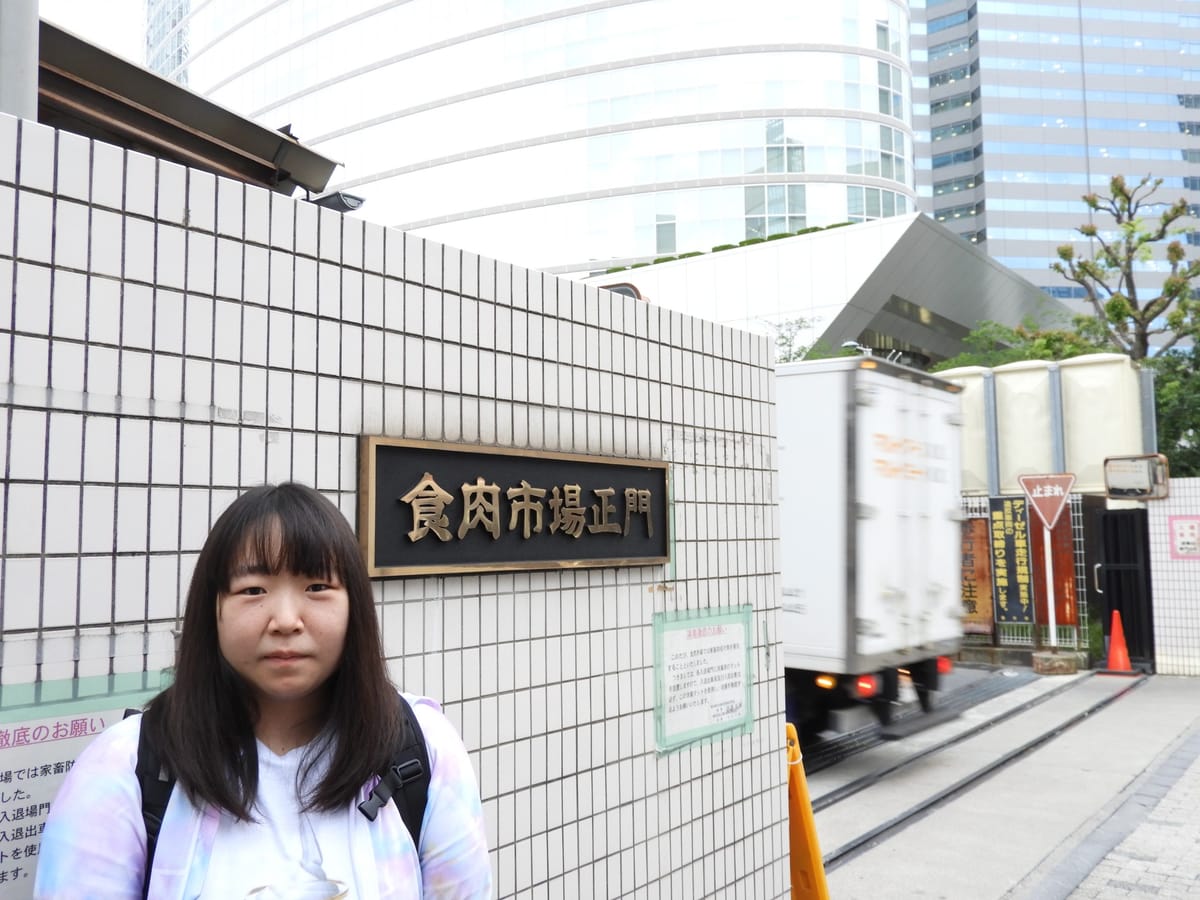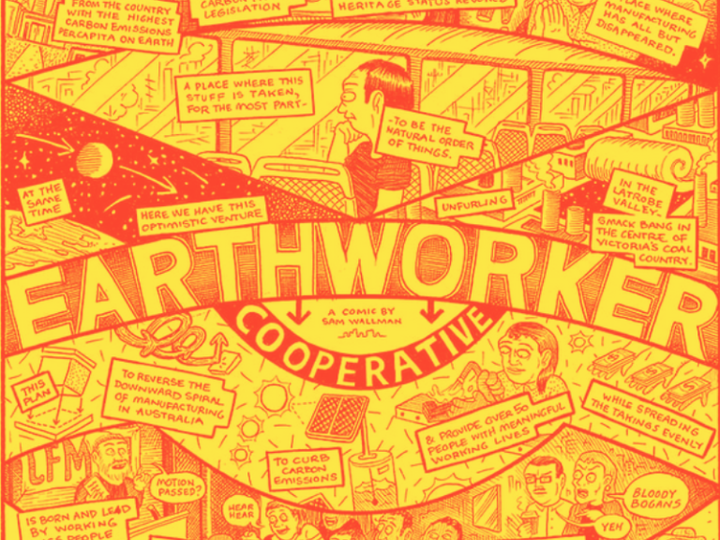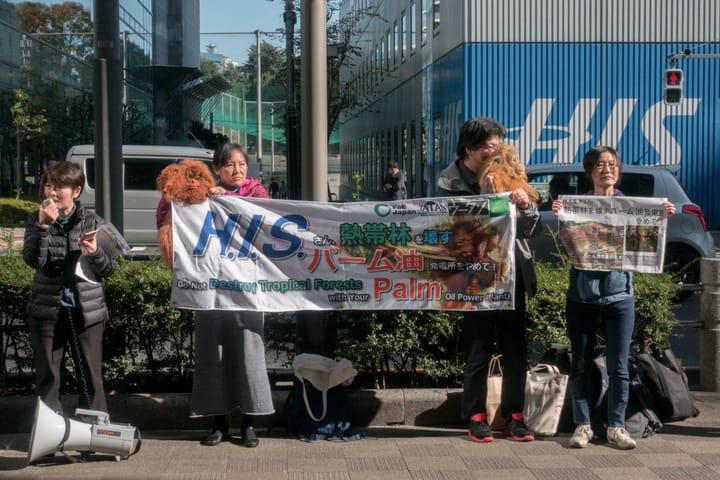A Cut Above the Rest:Shibata Akari
Shibata Akari is one of a small number of female slaughterhouse workers in an industry steeped in discrimination and where workers were not even paid until the 1970s.

Shibata Akari loves her job.
“Little by little, I feel my skill advancing, and that’s what really makes me happy. There are days I do very well and days I don’t do well, but I always think someday I will be much better than this sempai (mentor). That’s my objective,” says Shibata, a line worker at Shokuniku Shijo, more formally known as the Tokyo Central Wholesale Market. Located steps away from JR Shinagawa Station, one of Tokyo’s busiest and a historical trade hub, the site is one of 11 wholesale markets operated by the city since the 1860s to ensure food safety and sanitation issues.
Shokoniku Shijo processes roughly 430 cows and upwards of 1,400 pigs daily into meat that makes its way to supermarkets, restaurants, and finally, dinner tables around the city. “Our work is important to survive,” says Shibata. “It’s indispensable. Especially in Tokyo and for the people of Japan, we are their kitchen. That’s what our location here in Shinagawa means.”
A third-generation worker at the slaughterhouse, Shibata grew up hearing her father and grandfather discuss their work with family, friends, and colleagues. She dreamed of following in their footsteps, drawn by the camaraderie and the skill required to do the work. However, after high school, thinking she didn’t have the physical strength to do the job, she took an office job with a meat distributor.
Shibata enjoyed the work – interacting with different buyers and visiting the high-end restaurants where the meat, often the highest grade of beef, was prepared by professional chefs – but after three years, she felt restless. When her father suggested she try for an opening at the slaughterhouse, she jumped at the chance.
Offered only once a year in January, applicants submit a resume, take a two-part test that consists of both a physical and a written component followed by two interviews. Applicants do various strength and endurance tests including side steps, sit-ups, and undergo a core strength assessment, while the written component is an essay.
It can be about anything,” says Shibata, “ranging from ‘What do you think about HACCP (Hazard Analysis and Critical Control Points) or the new international sanitary law or your thoughts on the Tokyo Metropolitan Government running the meat processing plant.”
It took Shibata three tries before she passed and was able to join her father on the line. She is one of six women working on the slaughterhouse floor.
“They never tell you which part you pass or which part you fail,” she says. “You just know you failed and have to try again if you want to work there.”
Her first job on the slaughterhouse floor was bringing the pig carcass to the last stage where it gets cut in half. Hung from the ceiling, Shibata pushed the carcass until it was positioned in front of the automatic cutter.
“At first, I didn’t know anything, so I enjoyed it,” Shibata says, “but when I got used to it, it wasn’t so stimulating. I didn’t have to use knives or anything, so I didn’t feel like I was growing or learning. However, now that I’ve worked all the stages, I know how much effort, technique, and labor it takes for one carcass to come around to that end.”
New workers are assigned various positions along the meat processing line and stay there until a senior mentor feels they have mastered the necessary techniques and skills to move on to another position. However, the time required for that mastery depends on the person.
“Some people complete a particular phase in half a year while others can remain there a whole year. For example, I was able to master skinning around the shoulders as a pre-process and become a regular in half a year.”
“I’ve gotten better, but I still make mistakes,” she adds. “Sometimes I can see my sempai next to me making up for mistakes I’ve made. What’s important is to lighten the workload for the person next to me working on the next stage. That’s the challenge. If I do a mediocre job, that’s going to be a burden to everyone after me.”
Before stepping through a sterile room that separates the slaughterhouse floor from the rest of the building, Shibata dons a white cotton suit, rubber boots, and hard hat. She also adds a set of three gloves. First is a pair of thin rubber gloves that keep her hands dry as she washes the pig and begins cutting the carcass, followed by a pair of metal-threaded gloves. These prevent a knife blade from nicking her hands or fingers. On top of those two she wears a pair of thick rubber gloves. These again keep her hands dry but also protect them from the boiling water used regularly throughout the process to keep the meat as clean as possible.

Shibata also wears a metallic-thread forearm cover to protect her forearms as she works. Attached to a belt on the outside of her suit, she routinely carries a selection of large and small knives useful for whatever the task at hand requires. Finally, on her belt is also a sharpener, a long cylindrical piece of metal that she uses regularly throughout her shift to ensure that each of the blades she carries is as sharp and efficient as possible.
Knives don’t wear out so much as dwindle in size. Shibata sharpens her knives multiple times a day as needed, and in one to two years the result is a blade that is a fraction of the original size. The sharpener, though, lasts longer and gets passed down from generation to generation, sempai to apprentice. Shibata’s, for example, was gifted to her by her mentor when she started.
Shibata currently finds herself near the beginning of the process for pigs. Working simultaneously with 24 others forming lines on either side of a single carcass, she removes the head and shoulder hide while others remove internal organs and the remainder of the hide. She estimates that it takes them an average of 25 minutes to process a 120 kg pig from initial gassing to splitting the carcass.
“You always have to be aware of the people around you and what they are doing,” Shibata says. “For instance, if you cut into a hide or forget to shave off excess fat, you have to wash it, and that slows everything down. At that time, one person might be working to fix it and everybody else has to make up for his lost time. To be able to quickly respond to that, you always have to watch around you. You must be able to detect that at some point some process is delayed and move around to cover for that person’s empty space.”
Highly skilled work like Shibata’s might be integral to feeding people safe, healthy food, but in Japan the people who work in slaughterhouses are looked down upon and often discriminated against. Much of that has to do with history and culture.

According to traditional Buddhist and Shinto beliefs, those who slaughtered animals, executed criminals, worked in the tanning industry, or as undertakers are members of the lowest caste of society.
During the 17th century, they were labeled as eta (filth) or hinin (non-human). Despite the abolition of the caste system in 1871, prejudice against this group of people, commonly known today as Burakumin (people of the village) continued even as meat became a more prominent part of the Japanese diet starting in 1872 when a 1,200-year-old-ban on eating meat was lifted in conjunction with a push to Westernize. (The ban began in 675 A.D. with the arrival of Buddhism and a subsequent fear of eating reincarnated ancestors.) The warehouse still regularly receives hate mail, and many of Shibata’s coworkers don’t tell their children what they do for work for fear of bullying or other retaliation.
It was not until 1973 that many of these workers received actual wages for their labor. Those who processed offal for use in stews or other dishes were managed by a separate company and paid in kind for their labor. When they were asked to move up to the slaughterhouse floor to help during a labor shortage, they were not considered employees and not given wages.
With the help of union organizer, Tsutomu Ben Watanabe, the first of two unions, the All Shibaura Slaughterhouse Union, was established in 1971 to help workers advocate for improved safety standards, fair wages, and official employment status from the Tokyo Metropolitan Government. Negotiations went on for two years. When Tokyo ultimately hesitated to agree, the workers went on a now famous one-hour strike in 1973 and won.
It is a lesson the unions and Shibata have not forgotten. A similar one-hour strike in November 2008 to protest a proposed 15-percent pay cut had a similar effect.
The union also organizes regular education sessions for school children and community members. Led by union members and floor workers, the sessions provide not only an overview of the slaughterhouse operation but put their work and their successful labor movement into historical and social context.
“We do this activism because we want to eliminate discrimination against people who work here and do this job,” says Shibata. “When people come here, they hear what I have to say. I want them to remember me and my face when they sit down to eat.”
For Shibata, who currently serves as treasurer for the union and its youth division, this activism is one of the most satisfying parts of her work, as important and integral as mastery of a position along the line.
“I want people to understand that we don’t do this job reluctantly. We take pride in our work. I think work in general should be like that,” Shibata continues. “People should feel a sense of pride in what they do no matter what. Our job is just one of many, but we are proud to do it.”


